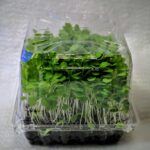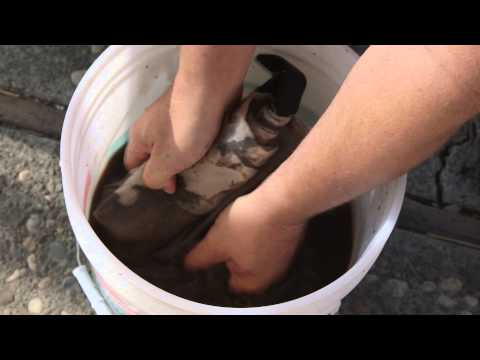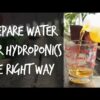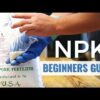How to Make Organic Liquid Fertilizer for a Hydroponics System
This video gives step by step instructions on how to make your own organic liquid fertilizer to use in your hydroponic system.
Organic Nutrients Used to Make Organic Liquid Fertilizer for a Hydroponics System
There are a few different approaches to obtaining and using organic nutrient sources in a hydroponic system. It can be difficult to get a balanced and suitably high ratio of all the essential minerals from organic sources alone, so you should experiment with different products. There is a range of liquid organic nutrient concentrates on the market, as well as some fertilizer salts that are considered organic and naturally occurring to help boost growth where required.
Minerals
Generally, sulphate trace elements, such as iron sulphate, copper sulphate, zinc sulphate, manganese sulphate and magnesium sulphate (Epsom salt), are allowed under organic production, so you can use these to help round out any deficiencies that may occur with organic nutrients.
An organic iron chelate can be made by mixing iron sulphate with citric acid powder to replace the synthetic iron chelate (EDTA or DTPA) commonly used in traditional hydroponics to ensure ongoing iron availability. Growers often need to blend two or more organic liquid fertilizers to provide sufficient and balanced nutrient levels for most hydroponic crops.
Emulsions
An organic base product (often a concentrated fish emulsion base or similar) blended with organic liquid calcium is a good place to start. An organic nitrogen product may be required later on. Growers should aim to use products that have been designed for soilless systems wherever possible.
The main difficulty with running organic systems is obtaining sufficient amounts of nitrogen and calcium, which are required in large amounts by plants. Organic systems rely on microbes in the root zone to convert organic compounds into plant-available nitrogen sources and sometimes this process does not occur fast enough for uptake.
Calcium is difficult to obtain rapidly from organic nutrients as it relies on the breaking down of calcium-containing materials such as limestone. Growers who have hard water sources containing naturally occurring calcium have a major advantage in this case because this form of calcium is readily available for plant uptake.
Vermiculture
It is possible to make an organic nutrient solution completely from raw materials rather than relying on commercially bottled products. While liquid bio-digesters that turn raw organic materials into usable plant nutrients have been used by some growers, the more reliable method for smaller systems is vermiculture (worm farming).
Vermiculture is a highly efficient way of processing high-mineral raw materials, such as manures, limestone, blood and bone, fish meal, seaweed meal, guano and others, into usable, mineralized hydroponic nutrient solutions that also provide the benefits of a diverse population of beneficial microbes. It’s easy to make your own worm castings!
Possible Problems
One of the main problems with organic nutrients is concentration. Most organic liquid products are not as concentrated as standard, salt-based fertilizer formulations, so plants may become weak, stretched and more prone to disease.
Growers need to be aware of what underfed plants look like and boost nutrient concentrations as soon as these conditions are detected. Nutrient additives and boosters, such as humic and fulvic acid, are a good addition to organic systems as they help facilitate nutrient uptake and are generally considered organic.
Before you jump on the “organic” train, check out another video blog of mine on Conventional vs. Organic Hydroponics.
Please note that this site is supported by affiliate marketing which means that a small portion will be paid to maintain this site from any purchases made through it. This in no way affects the price of the products on this page.
Conclusion – How to Make Organic Liquid Fertilizer for a Hydroponics System
Frankly, plants only use chemical nutrients. If these are found in rotting vegetation or worm castings then the plant takes the required chemical nutrients from these addendums in order to grow OR they can take it from a bottle that is made up of the exact nutrients that the plant needs. The trick in making your own organic fertilizer is to get all of the macronutrients (NPK) in proper proportion while also ensuring all of the micronutrients are present as well. This can take a fair bit of trial and error but some feel it is worth-while.
I look forward to seeing your comments and ideas! Please follow and share!
Related Posts
Can You Profit From Hydroponics?


5 (8) Did you hear the story of a farmer who started growing strawberries? Yes? But, do you know he…
Conventional vs. Organic Hydroponic Nutrients


0 (0) Are “Organic” nutrients really better for your system or for your customers? Find out in this video from…








I’m a big strawberry fan and I’ve been looking for ways to grow them myself, especially because where I live we don’t have them all year long. I started looking into hydroponic systems and they do seem very interesting. My dad is more of a gardener than I am, but he wants me to learn this stuff on my own. I learned a lot from your post and look forward to implementing what I learned.
Strawberries are the perfect plant for indoor hydroponics. You will have huge, luscious strawberries in no time!
Thank you very much for this tips, I just noted a point, FISH EMULSION. I am a student in a university in Brazil (name withheld) and my field is related to agriculture. We have to submit a research proposal in 2 weeks. I have interest in doing a research on liquid fertilizer. But I didn’t have a good topic prior to this time; I’ve got something to write on now.
Many thanks to you.
LOLOLOL Thanks, Jordan! I’m glad I could help out and be your muse!
Thanks for this great review on tips on how to make natural liquid fertilizer, I have tried to make so many fertilisers on my own but all to no avail on the plant, it would not be effective on them, this is why I stopped but me seeing this kinda post made me realised am missing some things I ought to include when making it , thanks for sharing this tips
I’m so glad it helped, Rose! It’s very difficult to make your own fertilizer that is complete and it takes a lot of trial and error
Hello Darlene! Thank you for your post on how to make organic liquid fertilizer for a hydroponics system. Your article is a time saver and a great support for me ,as I always want to grow plants indoor like lemon tree or tomato but did not know from where to start. I really enjoyed every line because we can feel how you master growing plants indoor.
I also like and prefer the vermiculture technique ,because it is money saver.
Vermiculture is AWESOME and its a great way for you to be using those kitchen scraps to make the BEST fertilizer for your plants! Good luck, Eva!
Hi Darlene,
I don’t really have a heap of knowledge when it comes to the subject liquid fertilizer nevertheless I scoured through your website and I feel like I could really learn a lot from it. It’s thorough and you even have videos which in my book is a definite bonus.
Thank you, Brice! I’m so glad you enjoyed the information and the videos!
I’m curious to know, what are some of the pros and cons of organic vs non-organic. There is a lot of hype surrounding the word organic, but does it necessarily produce better plants? As someone who isn’t too adverse to chemicals being added to things (love me some processed snack foods), what benefits might using organic fertilizer have for me?
Just a genuine question. The article was very informative as to the how, but now I’m curious as to the why?
LOL – my thinking is the same as yours. Attempting to make your own organic mix is so hit and miss that I would not use it on my plants. It’s because of the hype that this article was included to try to help those who just MUST go “organic”. Frankly, plants only use nutrients in their chemical form so why not just give it to them straight and take the guesswork out of the equation. There are excellent products out there that are fine-tuned to every phase of your plants’ growth. Check out this article:
https://myindoorgrowsystems.com/ebb-and-flow-hydroponic-systems-go-vertical/
My mother-in-law is a huge gardening fan. But because of her age, outdoor gardening is not happening anymore. I like the video, as I’m a very visual person; I will have to set this up for her so she can start gardening again.
Natural liquid fertilizer seems like it would be quite complicated; how long did it take before you got it right. Here we have to compost all our kitchen scraps, so might as well make good use of it. I did try this outside, but then we started getting rat and mice issues.
Hopefully, that isn’t an issue with this.
Oh, I do hope you get your mom back into gardening indoors! It’s so much easier and won’t hurt her back. Natural liquid fertilizer IS quite complicated and I will not use it. This article is here for those who have an interest in it. Frankly, plants can only take up nutrients in their pure chemical form like N, P, and K as well as micro-nutrients. Making your own makes it a guessing game. I buy commercial fertilizers that come with VERY specific instructions on how to use them. Check out these articles for more on nutrients and also a couple of systems I think that your Mom would like:
https://myindoorgrowsystems.com/how-to-prepare-water-for-hydroponics-ph-tds-and-ppm/
https://myindoorgrowsystems.com/aeroponic-grow-systems-indoor-growing-and-more-with-aerogarden/
https://myindoorgrowsystems.com/ebb-and-flow-hydroponic-systems-go-vertical/
Wow, this is very interesting and informative article! My sister loves to grow her own garden using hydroponics system. I bet she will find this very useful, and I also learn new information because I also plan to grow some herbal plants by myself using this system. Thanks again for the article
I’m so glad you found this to be useful – thank you! You may also want to check out another article of mine that deals further with nutrients:
https://myindoorgrowsystems.com/how-to-prepare-water-for-hydroponics-ph-tds-and-ppm/
Wow that’s awesome! This information is very valuable. I had some plants that my friend gave me as a homecoming present that I worked so hard to take care of but it’s too cold and they died. I’ve been wanting to grow some roses and was discouraged by them dying. Now that I’m reading this article I realize that I can still grow them. Thank you so much
Hi there, Shazarre! I am so glad I was able to help! Thank you so much for your comments
It was around 4 months ago when I decided to invest in land in the suburb area for hydroponic purposes. It is mainly for vegetables like kale, green Romain and the like. Unfortunately, I could not maintain it all by myself. Purely because of my lack of time and knowledge on the matter. I think it’s time to get my hand dirty with all the practices. Reading this article boosting up my confidence and motivation.
I see no measurement mentioned for the mixture. I guess it’s left to us to experience it by testing? Hope more articles come on the subject.
Cheers.
Hiya Indra! Oh, I do hope you do get back into hydroponics! It’s so very rewarding. Unfortunately, measurements are impossible to give in organic mixes because each component can differ from batch to batch – like any kind of compost or worm castings. It really is a matter of trial and error however I have included one pre-made organic fertilizer that you can buy to eliminate a lot of the guesswork. Have fun with your project!
This was what I was looking for, a step by step guide how to make our own organic liquid fertilizer. After checking out your post, now I feel ready to grow Hydroponic plants with my own organic liquid fertilizer.
I have been reading that lemon is a very good option when creating our liquid fertilizer. I’ll use lemon.
Yes, lemon is good but will increase the acidity of the pH of your mix. Always test the pH of your hydroponic solution before adding lemon. This is covered in this post:
https://myindoorgrowsystems.com/how-to-prepare-water-for-hydroponics-ph-tds-and-ppm/
I’m glad you dedicated a section in this post to adrress the posible problems we may meet. I have been reading that one of the most common is organic nutrients concentration. I’ll study to learn how underfed plants look like. I want to be able to save them on time with nutrient additives and boosters.
Hi there, Paolo! If you just watch your plants you should be able to tell if they need something. Drooping leaves, algae growth, yellowing leaves, yellow spots on leaves are all things that should be watched for.
Very informative post. I took classes in horticulture some years ago as I was working in that industry at the time, but I still learned some things from reading this. I don’t work in the field anymore but I’m always looking for the best organic fertilizer for my house and yard plants. Some are grown in water with my beta fish but many are not. Are these organic nutrients and minerals pet-friendly? Thanks for the info.
~Melissa
Thank you, Melissa! Actually, the used water from your fish tank can also make good fertilizer! I would have to say that neither organic nor standard fertilizers are pet-friendly. If you wouldn’t eat it yourself, don’t let your pets at it. What plants need is far different from what humans need.
You mentioned not getting the organic fertilizer concentrated enough for the system and I am guessing that’s what causes some of my plants to rot. Do you have a specific calculation or formula to get the right mixture of fertilizer in order for the system to thrive? Any help is appreciated.
Hiya Cathy! Actually, rot is often due to bacteria that invade and destroys the roots. You need to increase the beneficial enzymes. This can be done over time with worm castings and such or you can buy a product like Hydrogard from Amazon at https://amzn.to/2DN3GzF which will infuse your plants with this enzyme. Unfortunately, in organic fertilizers, there is no way to give a specific recipe. Each variable is different. For example, the chemical composition of worm castings will be different from one lot to another. This is why a recipe is impossible to give and organic fertilizing is really hit and miss. That is why I use the chemical fertilizers as the plants only take up the chemicals (N,P,K and micro-nutrients) not the actual worm castings, kelp meal or other things you might use.